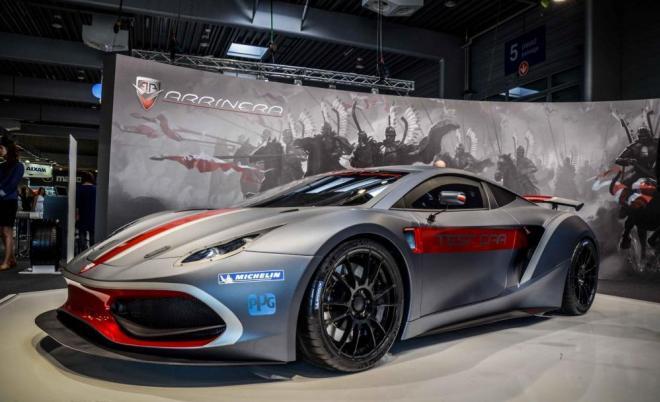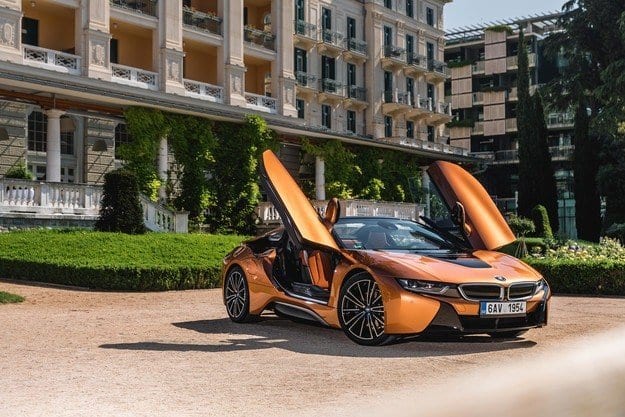
Szarża Hussaryi is a supercar made in Poland
To paraphrase a Renaissance poet, we can say that the Poles do not have geese and have their own supercar. Well, maybe not completely yet, because the Arrinera Hussarya is still a prototype, but work on it is slowly coming to an end.
Most people, when they hear that a real sports supercar is being built on the Vistula, smile indulgently, and a box with the words "April Fool's Joke" automatically opens in their minds. And no wonder, because Poland has squandered and squandered its automotive potential over the past two decades, and is the only large country from the group of former Demoludians that cannot boast of any domestic brand (even in the hands of a large corporation). Most of the factories of world magnates working in our country are ordinary assembly plants, and private initiatives aimed at creating a Polish car brand turned out to be ephemeris.
And yet Arrinera is a realistic project and developed with great consistency, as guests of the last car shows in Poznan, Warsaw or Birmingham could see, where modified prototypes of various versions of the Polish supercar were demonstrated. A group of enthusiasts from Arrinera played - they not only created a new car from scratch (which is already a great achievement), but also designed super sports car. Moreover, it is created in parallel in two versions: road and racing.
Arrinerę Hussaryę GT was shown at the beginning of the year at Autosport International in Birmingham, one of the most important motorsport-related industry events in Europe (2, 3). The car received a lot of positive feedback, both from specialists and from ordinary fans of four wheels. This is very important for its creators. The GT version will be used as the base car for the road car it announces. Petr Gnyadek, vice president of Arrinera Automotive: "It will have racing DNA with elements of luxury supercars."
polish racer
The crazy idea of creating the first Polish supercar was born in the head of Lukasz Tomkiewicz, who in 2008, together with Piotr Gniadek, founded Arrinera Automotive. As he emphasizes, such projects are born out of passion and mature over the years.
“In our case, this is the realization of a childhood dream,” says Tomkevich. Together with Gniadek - and a group of automotive enthusiasts gathered around them - in a small design office in the Warsaw district of Prague, they began work on a prototype that materialized three years later in the form Concept one, sports car with Audi engine. However, this project was only a warm-up before the creation of something much more original, which eventually took the form of Arrinery Hussaryi.
The name "Arrinera" comes from a combination of two words: (in Basque - streamlined) and Italian (real). In turn, the name of the model refers to the old Polish transcription of the word "hussars" - the most powerful cavalry of the times of the First Republic of Poland. Hussars were distinguished by extraordinary agility, speed and unique, recognizable style - the same features distinguish the Polish supercar.
Currently, about 40 people are involved in the work on Arrinera Hussaryia. The boss of the whole team is Гжегож Pen, adviser and expert of the largest automotive companies specializing in auto racing. He worked, including for Mosler Europe and then for Lotus Motorsport. It currently focuses exclusively on the Arriner. Also play an important role: Pavel Burkatsky - the stylist who designed the shape of the Arrinery hull and its individual details, as well as Peter Bilogan, the inventor of the Arrinery suspension system, the man behind the suspension and transmission systems of most F1 teams, was also the co-inventor of the Bugatti Veyron suspension. Project technical consultant, including Lee Noble is a British entrepreneur, designer and automotive engineer, and the world's leading designer and independent manufacturer of supercars.
The company also works closely with scientists from the Warsaw University of Technologywho takes i.a. participation in the work on the aerodynamics of the car. Last year, Arrinera and PW officially launched a three-year joint research program to develop a system to actively suppress vehicle traffic violations while improving driving stability.
For a long time, Arrinera focused on building a purely road version of the Hussarya, but for some time, work was secretly carried out on a racing version of the car. Its creators made a very correct assumption that the racing model will be an excellent testing ground for solutions that will later be transferred to the civilian version. The presence of the GT version also greatly enhances the prestige of the brand.
GT Model Specifications - the first Polish racer - looks promising. The basis of the entire car is a space frame made of steel BS4T45. This is the material used by the best teams in motorsport. body out fiber carbon. In turn, the floor and some interior elements are made of very durable kevlaru. This allowed to reduce the weight of the car to 1250 kg. As befits a GT model, the Hussaryia also features a lower front splitter, diffuser and large rear spoiler (5, 9). Another characteristic element of the car's silhouette is the air intake (7), which is part of the engine intake system.
Speaking of drive, here it is fork eight from GM, with a volume of 6,2 liters, developing, depending on the specification, from 450 to 650 hp, with a maximum torque of 580 to 810 Nm. The interior is like a racing car, raw but refined. The steering wheel has paddles for shifting gears in a 6-speed sequential Gearbox Hewland LLSwhich transfers all the power generated by the drive to the rear axle. Responsible for reading and writing vehicle parameters. Computer Cosworth ICD Pro - developed by the Polish company Exumaster. As the creators of the car emphasize, from the very beginning they were guided by the idea that Hussarya should be, as far as possible, a product of domestic technical thought, equipped with components manufactured by Polish companies. Foreign manufacturers order only those elements that we do not have, or their quality is not enough for this class of cars.
A good example of this philosophy is multi-link suspension – Patented Arrinery design for driving confidence and excellent traction. It consists of two double wishbones and Öhlins adjustable dampers and springs, which the Swedish manufacturer has made specifically for the car. The 380mm rims are from Alcon and the sporty ABS is from Bosch. We close the rich list of innovative solutions and branded components with the specification of tires and wheels: the first is the Michelin S8H model (8), and 18-inch lightweight wheels were supplied by Braid.
At the moment, the Arrinery GT prototype is under development. thoroughly tested. It has already passed, among others, the MIRA Wind Tunnel Test in the UK. As the designers of the car assure, they performed very well and confirmed that the solutions developed by scientists from the Warsaw University of Technology and Arrinera engineers work well “in combat”.
“We are particularly pleased with the performance of the front and rear diffusers and the triangular ridges on the front bumper – the so-called ones – says Piotr Gniadek. The latter significantly increase the downforce on the front axle of the rider. The engine has been dyno tested and in a moment at Öhlins headquarters, Swedish engineers will be fine-tuning the car's suspension. After fine-tuning the mechanics of the super-
the car will hit the test track this year as well. first polish car, will take part in one of the GT4 races (Open class) in Europe. There are many indications that one of the Polish racers will sit behind the wheel.
And his name is thirty and three
Although Arrinera Automotive is currently focused primarily on testing and promoting the GT version, this does not mean that it has abandoned work on the civilian version of the Hussarya, which was additionally designated with the number 33. This is exactly how many copies of this car are planned to be produced. produced by a Polish company, which, like the Swedish Koenigsegg or the Italian Pagani, relies on exclusivity and originality.
“We don't have the opportunity, but we also don't want to be the Polish equivalent of Ferrari or Porsche, we don't focus on mass production. (…) It will not be a “sports car for the people”, but a car for very wealthy people who already have ten models of Ferrari or McLaren in their garage, a little unsure what else to add to their collection, so they buy Pagani, buy Koenigsegg, and in the future, Arrinera may also be bought,” said Lukasz Tomkiewicz, president of the company, in an interview for the TechnoTrendy blog.
The Hussarya GT is intended to promote the Arrinera in the world and set the stage for the civilian version that Polish engineers are working on in parallel with the racing version.
“Creating a global new brand is not an easy task, which is why we approach a project with attention to every detail. The premiere of a car can only happen once, so we believe that it is better to improve and change the project than to show the world an unfinished car,” explains Piotr Gnyadek. Externally, the car will be very similar to the Hussarya GT (the elements typical of racing cars will disappear), but will receive luxurious equipment with an interior created by the Polish company Luc & Andre. The range of engines supplied by GM will also expand. The most powerful engine, the 8-liter V8, has so far been able to squeeze almost 900 hp on the dyno. Perhaps in the future Hussarya will also receive V12 engines and an electric drive.
The car will be about 100 kg heavier than the racing version, but some body parts will be made of graphene - supermaterial with amazing properties that will increase the resistance of the car to damage. Polish engineers have developed a special 33rd for Hussarya active spoiler auxiliary braking system and allowing to shorten the braking distance at a speed of 300 km / h. for several tens of meters. The car will also be highlighted by the original semi-gloss body colors developed exclusively for the Arrinera by PPG Industries.
The final price of the road version has not yet been determined, although it is likely to be higher. 1,5 million zł. However, if someone has a taste for the GT model, they should have at least 840 XNUMX. zloty.
The first attempts
Describing this extraordinary project, one cannot fail to mention at least a few words about the first historical attempts to build a sports car.
Without a doubt, the most interesting prototype was the famous sports siren. The car, which Western automotive journalists called "the most beautiful car from behind the Iron Curtain", was developed in 1958. engineer Caesar Navrot from the Warsaw FSO. The team that worked on this model included Zbigniew Lebecki, Ryszard Brenek, Wladyslaw Kolasa, Henryk Semensky and Wladyslaw Skoczyński, who rebuilt the Junak four-stroke motorcycle engine for the Syrena, adding Panhard Dyna drive elements. Engine power (25 hp) was rather weak even for those times, but it accelerated the car to over 110 km/h. This was due in no small part to the innovative body structure, which, including the windows, was made entirely of from synthetic materialswhich was a revolutionary idea at the time. The Syrena Sport was a two-seater and the roof could be easily removed to turn it into a roadster. Access to the engine is solved in an original way - the entire front part of the body is raised on hinges located at the foot of the windshield. The rear suspension was multi-link.
Unfortunately, the then authorities did not like the project, who considered it bourgeois and too extravagant for the representatives of the working class. The prototype was ordered to be placed in the warehouse of the Research and Development Center in Warsaw Falenica, where it was destroyed by the commission in 1975.
Around the same time that the last traces of the beautiful Sirena were erased, the second prototype car with sporty genes was created - Polish Fiat 1100 Coupe. Like the Sirena, the car was sporty only on the outside, the engine and gearbox from the Fiat 128 at the rear did not allow for a dynamic ride. On the other hand, the silhouette of the car, although based on the Fiat 125p, was very extravagant and aerodynamic. In the political and economic realities of that time, this model also had no chance of entering mass production.
It's a pity those wasted ideas of many years ago. Moreover, we must keep our fingers crossed for the success of the Arrinery project. An all-Polish supercar, refinished and finished, available in two versions – road and racing – would be something completely new on the market and perhaps give the impetus to break the vicious cycle of automotive incapacity in our country.

